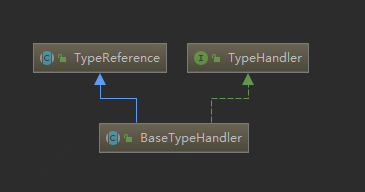mybatis关于ORM的使用以及设计(三)[参数对象转换为SQL语言]
上节分析了Mapper对象的创建。
在ORM的定义中可以理解为Object->SQLMapper抽象层(这一层并不负责具体的SQL执行。这一层可以理解为SQL代理层)
本节分析以下内容:
①SqlSession在具体执行SQL时,如果通过namespace+sqlid定位到具体的MappedStatement(sql的对象化表现形式)
②参数(Object) 如何填充到具体的SQL
③SQL是如何执行的
- 获取StateMentMapper.前面讲到初始化时,会缓存MappedStatement,MappedStatement被保存在StrictMap中.
StrictMap是Mybatis实现HashMap子类。Key重复放入的时候会报错。

- 参数(Object) 如何填充到具体的SQL(Param-SQL的Orm转换)
1、通过Executor执行SQL
@Override
public <E> List<E> selectList(String statement, Object parameter, RowBounds rowBounds) {
try {
MappedStatement ms = configuration.getMappedStatement(statement);
return executor.query(ms, wrapCollection(parameter), rowBounds, Executor.NO_RESULT_HANDLER);
} catch (Exception e) {
throw ExceptionFactory.wrapException("Error querying database. Cause: " + e, e);
} finally {
ErrorContext.instance().reset();
}
}
2、Executor是如何获取的?
SqlSessionFactory工厂中代码如下:
从Configuration中获得Excecutor,默认的执行器类型为configuration.getDefaultExecutorType()在configuration类中定义为
protected ExecutorType defaultExecutorType = ExecutorType.SIMPLE;
private SqlSession openSessionFromDataSource(ExecutorType execType, TransactionIsolationLevel level, boolean autoCommit) {
Transaction tx = null;
try {
final Environment environment = configuration.getEnvironment();
final TransactionFactory transactionFactory = getTransactionFactoryFromEnvironment(environment);
tx = transactionFactory.newTransaction(environment.getDataSource(), level, autoCommit);
final Executor executor = configuration.newExecutor(tx, execType);
return new DefaultSqlSession(configuration, executor, autoCommit);
} catch (Exception e) {
closeTransaction(tx); // may have fetched a connection so lets call close()
throw ExceptionFactory.wrapException("Error opening session. Cause: " + e, e);
} finally {
ErrorContext.instance().reset();
}
}
ExecutorType.SIMPLE会创建何种执行器?
来看Configuraiton的获得执行器的方法
默认的执行器为:SimpleExecutor,而cacheEnabled默认值为true.所以实际是CachingExecutor,使用了装饰器模式。
public Executor newExecutor(Transaction transaction, ExecutorType executorType) {
executorType = executorType == null ? defaultExecutorType : executorType;
executorType = executorType == null ? ExecutorType.SIMPLE : executorType;
Executor executor;
if (ExecutorType.BATCH == executorType) {
executor = new BatchExecutor(this, transaction);
} else if (ExecutorType.REUSE == executorType) {
executor = new ReuseExecutor(this, transaction);
} else {
executor = new SimpleExecutor(this, transaction);
}
if (cacheEnabled) {
executor = new CachingExecutor(executor);
}
executor = (Executor) interceptorChain.pluginAll(executor);
return executor;
}
- Excecutor是如何将参数成功映射到具体SQL的参数?
先看下MappedStatement中的类成员构成。sqlSource是具体获取待执行SQL的对象。

- sqlSource接口定义:
BoundSql getBoundSql(Object parameterObject)的方法,改方调用实际的SqlSource的实现类,来获取真正执行的SQL

先说说几个处理类的区别:
DynamicSqlSource:sql中包含<where><if><choose>等条件是,会被定义为.通过具体的Node处理对象,拼接SQL。
看一段代码,我们关注rootSqlNode变量,以及getBoundSql()方法的执行。
public class DynamicSqlSource implements SqlSource {
private final Configuration configuration;
private final SqlNode rootSqlNode;
public DynamicSqlSource(Configuration configuration, SqlNode rootSqlNode) {
this.configuration = configuration;
this.rootSqlNode = rootSqlNode;
}
@Override
public BoundSql getBoundSql(Object parameterObject) {
DynamicContext context = new DynamicContext(configuration, parameterObject);
rootSqlNode.apply(context);
SqlSourceBuilder sqlSourceParser = new SqlSourceBuilder(configuration);
Class<?> parameterType = parameterObject == null ? Object.class : parameterObject.getClass();
SqlSource sqlSource = sqlSourceParser.parse(context.getSql(), parameterType, context.getBindings());
BoundSql boundSql = sqlSource.getBoundSql(parameterObject);
for (Map.Entry<String, Object> entry : context.getBindings().entrySet()) {
boundSql.setAdditionalParameter(entry.getKey(), entry.getValue());
}
return boundSql;
}
解析过程描述:
①rootSqlNode为从XML解析的具体SQL节点,每一行作为一个node。对于<if><choose>等。每一个节点是一个node
②<if></if>的判断是在具体的node中执行的。SQLNode有以下几种类型。

看一段IfSqlNode的代码:apply方法中的evaluateBoolean方法,将对<if>语句进行判断,返回结果。如果结果为真,则把条件添加到contents
/**
* @author Clinton Begin
*/
public class IfSqlNode implements SqlNode {
private final ExpressionEvaluator evaluator;
private final String test;
private final SqlNode contents; public IfSqlNode(SqlNode contents, String test) {
this.test = test;
this.contents = contents;
this.evaluator = new ExpressionEvaluator();
} @Override
public boolean apply(DynamicContext context) {
if (evaluator.evaluateBoolean(test, context.getBindings())) {
contents.apply(context);
return true;
}
return false;
} }
mybatis中定义的SQL节点如下。

RawSqlSource:对于不包含<if>等条件判断,替换#{}变为? 在创建RawSqlSource对象时执行这项操作
DynamicSqlSource: 对sql中包含${}参数的会转换为该对象
- SqlSource的转换是在初始化加载时完成。那真正的参数是何时转换为SQL?
SimpleExecutor中,创建PrepareStateMent的过程。
public <E> List<E> doQuery(MappedStatement ms, Object parameter, RowBounds rowBounds, ResultHandler resultHandler, BoundSql boundSql) throws SQLException {
Statement stmt = null;
try {
Configuration configuration = ms.getConfiguration();
StatementHandler handler = configuration.newStatementHandler(wrapper, ms, parameter, rowBounds, resultHandler, boundSql);
stmt = prepareStatement(handler, ms.getStatementLog());
return handler.<E>query(stmt, resultHandler);
} finally {
closeStatement(stmt);
}
}
private Statement prepareStatement(StatementHandler handler, Log statementLog) throws SQLException {
Statement stmt;
Connection connection = getConnection(statementLog);
//创建、初始化PreparedStatement
stmt = handler.prepare(connection, transaction.getTimeout());
//设置参数
handler.parameterize(stmt);
return stmt;
}
离我们想知道的真相越来越近了,来看具体的参数化过程
StateMentHandler.parameterize

RoutingStatementHandler用来做路由器:根据实际的StatementType做路由
我们来看PreparedStatementHadler
public void parameterize(Statement statement) throws SQLException {
this.parameterHandler.setParameters((PreparedStatement)statement);
}
public void setParameters(PreparedStatement ps) {
ErrorContext.instance().activity("setting parameters").object(this.mappedStatement.getParameterMap().getId());
//获得所有的参数
List<ParameterMapping> parameterMappings = this.boundSql.getParameterMappings();
if (parameterMappings != null) {
for(int i = 0; i < parameterMappings.size(); ++i) {
ParameterMapping parameterMapping = (ParameterMapping)parameterMappings.get(i);
if (parameterMapping.getMode() != ParameterMode.OUT) {
String propertyName = parameterMapping.getProperty();
Object value;
if (this.boundSql.hasAdditionalParameter(propertyName)) {
value = this.boundSql.getAdditionalParameter(propertyName);
} else if (this.parameterObject == null) {
value = null;
//如果有typeHandler则用TypeHandler处理参数
//一些基础类型是有typeHandler的
} else if (this.typeHandlerRegistry.hasTypeHandler(this.parameterObject.getClass())) {
value = this.parameterObject;
} else {
//如果没有typeHandler,通过反射,获得Bean参数中的值
MetaObject metaObject = this.configuration.newMetaObject(this.parameterObject);
value = metaObject.getValue(propertyName);
}
//根据参数的JDBCtype找到TypeHandler,设置到PrePareStatement中
TypeHandler typeHandler = parameterMapping.getTypeHandler();
JdbcType jdbcType = parameterMapping.getJdbcType();
if (value == null && jdbcType == null) {
jdbcType = this.configuration.getJdbcTypeForNull();
} try {
typeHandler.setParameter(ps, i + 1, value, jdbcType);
} catch (TypeException var10) {
throw new TypeException("Could not set parameters for mapping: " + parameterMapping + ". Cause: " + var10, var10);
} catch (SQLException var11) {
throw new TypeException("Could not set parameters for mapping: " + parameterMapping + ". Cause: " + var11, var11);
}
}
}
}
}
TypeHandler的继承关系如下:


我们查看其中的BigDecimalTypeHandler的源码
public class BigDecimalTypeHandler extends BaseTypeHandler<BigDecimal> {
@Override
public void setNonNullParameter(PreparedStatement ps, int i, BigDecimal parameter, JdbcType jdbcType)
throws SQLException {
ps.setBigDecimal(i, parameter);
}
@Override
public BigDecimal getNullableResult(ResultSet rs, String columnName)
throws SQLException {
return rs.getBigDecimal(columnName);
}
@Override
public BigDecimal getNullableResult(ResultSet rs, int columnIndex)
throws SQLException {
return rs.getBigDecimal(columnIndex);
}
@Override
public BigDecimal getNullableResult(CallableStatement cs, int columnIndex)
throws SQLException {
return cs.getBigDecimal(columnIndex);
}
}
会调用JDBCAPI中的相应方法获得正确的值
mybatis关于ORM的使用以及设计(三)[参数对象转换为SQL语言]的更多相关文章
- mybatis关于ORM的使用以及设计(二)[DaoInterface 转换 Mapper代理对象]
第一节中,分析了Mybatis的ORM框架的初始化,这篇来分析SQL执行过程中,对象->SQL是如何转换的 其中包含两种映射思想 ①DAO接口->Mapper实例 ②执行DAO的方法时,参 ...
- mybatis关于ORM的使用以及设计(一)[ORM的初始化]
ORM WIKI中的解释.画重点 Object-relational mapping (ORM, O/RM, and O/R mapping tool) in computer science is ...
- c# 轻量级 ORM 框架 之 DBHelper 实现 (三)
周末了比较清闲,把自己的orm框架整理了下,开源了. 已经做出来的东西通常感觉有些简单,一些新手或许听到"框架"一类的词觉得有些"高深",简单来说orm就是把a ...
- [simple-orm-mybaits]基于Mybatis的ORM封装介绍
目录 前言 ORM框架现状 Mybatis优缺点 simple-orm-mybatis设计思路介绍 simple-orm-mybatis使用说明 simple-orm-mybatis实际使用 推荐最佳 ...
- ORM表之间高级设计
ORM表之间高级设计 一.表的继承 # db_test1 # 一.基表 # Model类的内部配置Meta类要设置abstract=True, # 这样的Model类就是用来作为基表 # 多表:Boo ...
- JdbcTemplate 、Mybatis、ORM 、Druid 、HikariCP 、Hibernate是什么?它们有什么关系?
JdbcTemplate .Mybatis.ORM .Druid .HikariCP .Hibernate是什么?它们有什么关系? 学完Spring和SpringMVC之后,就急于求成的开始学习起Sp ...
- JavaScript框架设计(三) push兼容性和选择器上下文
JavaScript框架设计(三) push兼容性和选择器上下文 博主很久没有更博了. 在上一篇 JavaScript框架设计(二) 中实现了最基本的选择器,getId,getTag和getClass ...
- MyBatis学习(三)、动态SQL语句
三.动态SQL语句 有些时候,sql语句where条件中,需要一些安全判断,例如按某一条件查询时如果传入的参数是空,此时查询出的结果很可能是空的,也许我们需要参数为空时,是查出全部的信息.使用Orac ...
- 游戏UI框架设计(三) : 窗体的层级管理
游戏UI框架设计(三) ---窗体的层级管理 UI框架中UI窗体的"层级管理",最核心的问题是如何进行窗体的显示管理.窗体(预设)的显示我们前面定义了三种类型: 普通.隐藏其他.反 ...
随机推荐
- 陕西柴油机--机械ip--------》QQ请求汇创
我们发现 String.substring()所返回的 String 仍然会保存原始 String,其实substring中生成的字符串与原字符串共享内容数组是一个很棒的设计,这样避免了每次进行sub ...
- django用MySQL数据库链接
在使用的过程中出现了没有mysqld.sock这个文件的情况,无法连接到mysql数据库. 几经周折,设置路径,改文件夹的权限,也都无济于事,只有重新安装mysql服务器,第一次尝试还是失败,服务器安 ...
- hive从本地导入数据时出现「Execution Error, return code 1 from org.apache.hadoop.hive.ql.exec.MoveTask」错误
现象 通过load data local导入本地文件时报无法导入的错误 hive> load data local inpath '/home/hadoop/out/mid_test.txt' ...
- 初学io
IO流: 01.File 创建文件 //创建文件夹 private static void mkdirs() { System.out.println("请您输入创建的文件夹名称:(默认是E ...
- css常用选择器选择器
tap选择器 ulclass选择器 .id选择器 #后代选择器 a b子代选择器 a>b兄弟选择器 a + b 以a为参考给b加样式属性选择器 input [type="text&qu ...
- Python3.7 练习题(三) 将指定目录下的图片进行批量尺寸大小处理
# 将指定目录下的图片进行批量尺寸大小处理 #修改图片尺寸 导入Image os 快捷键 alt+enter import os from PIL import Image def process_i ...
- java中字符串"1999-10-01T00:00:00+08: 00" 转化为Date格式
String oldStr = "1999-10-01T00:00:00+08: 00": SimpleDateFORMAT sdf = new SimpleDateFORMAT ...
- java第二章总结与感想
本章主要介绍Java程序设计环境,下面一节一节的记录: 2.1 安装java工具箱(JDK): 2.1.1, 下载JDK: 这一节主要介绍了以下知识点: (1)jdk的下载地址: (2)一些java术 ...
- 使用getInstance()方法的原因及作用
使用getInstance()方法的原因及作用 先举例说明: 下面是一个例子,为什么要把这个类实例化?有什么好处? //实例化 public static DBConnect instance; pu ...
- [Java Web学习]Spring MVC使用普通类对象,声明的对象为null
由于对Spring还不熟悉,目前还处于学习阶段,因此经常会遇到一些小白问题,这个问题需要在Spring文件中将普通对象注入bean,然后在MVC中添加set方法,填充普通对象.
